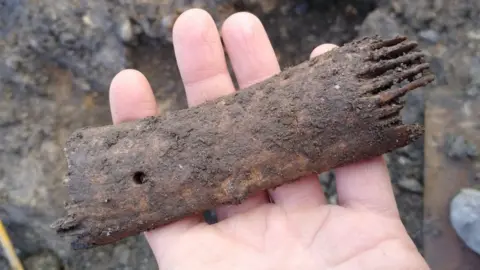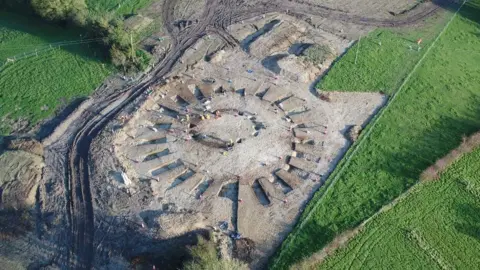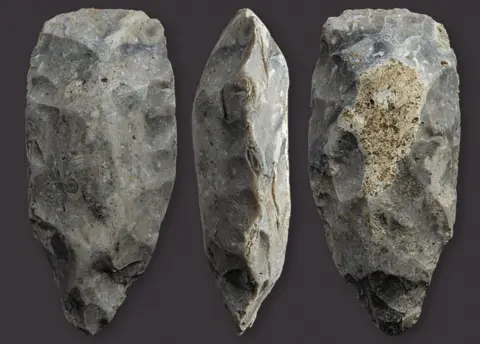Dorset power cable scheme uncovers 6,000 years of history
 Oxford Archaeology
Oxford ArchaeologyA project to remove electricity pylons from a protected landscape has led to archaeological discoveries dating back 6,000 years.
The National Grid is burying six miles (9km) of power cables in Dorset's Area of Outstanding Natural Beauty (AONB), near Winterbourne Abbas.
Excavations ahead of the works revealed a Roman settlement as well as Neolithic and Bronze Age finds.
The oldest artefacts were flint tools and pottery from about 4,000 BC.
 Oxford Archaeology
Oxford Archaeology Oxford Archaeology
Oxford ArchaeologyMore than 25 researchers from Oxford Archaeology spent 22 months carrying out investigations, focussing on six locations along the route west of Dorchester.
Work concluded last month and initial results are being revealed in a series of webinars hosted by the National Grid.
At one of the sites, they unearthed eight stone buildings from the late Roman period, along with a corn drier, two large malting ovens and several millstones that would have needed cattle, water or slave power to operate.
 National Grid
National Grid Oxford Archaeology
Oxford ArchaeologyArchaeologists also found 34 burials accompanied by Iron Age pottery, suggesting the site was occupied for about 500 years.
The investigations, which involved Historic England, the Dorset AONB Partnership and the Dorset county archaeologist, also revealed a cremation cemetery, believed to be Bronze Age, and 11 barrows - or burial mounds.
Oxford Archaeology senior project manager John Boothroyd said, although the archaeological potential of the sites had been assessed during pre-construction works, "it didn't stop the scale of the archaeological remains identified far exceeding our expectations".
 Oxford Archaeology
Oxford ArchaeologyAnalysing and recording the thousands of finds is expected to take up to two years.
National Grid lead project manager Paul Hamnett said: "The scale of the archaeology work is incredible. This is a scheme designed to enhance the landscape and enrich local experience. We are looking forward to sharing what we've discovered."
The Dorset Visual Impact Provision project involves the removal of 22 pylons from the area which is designated as a landscape of national importance.
Dorset AONB is the fifth largest in the UK. It stretches from Lyme Regis to Poole Harbour and inland to Blandford.

Follow BBC South on Facebook, Twitter, or Instagram. Send your story ideas to [email protected].
